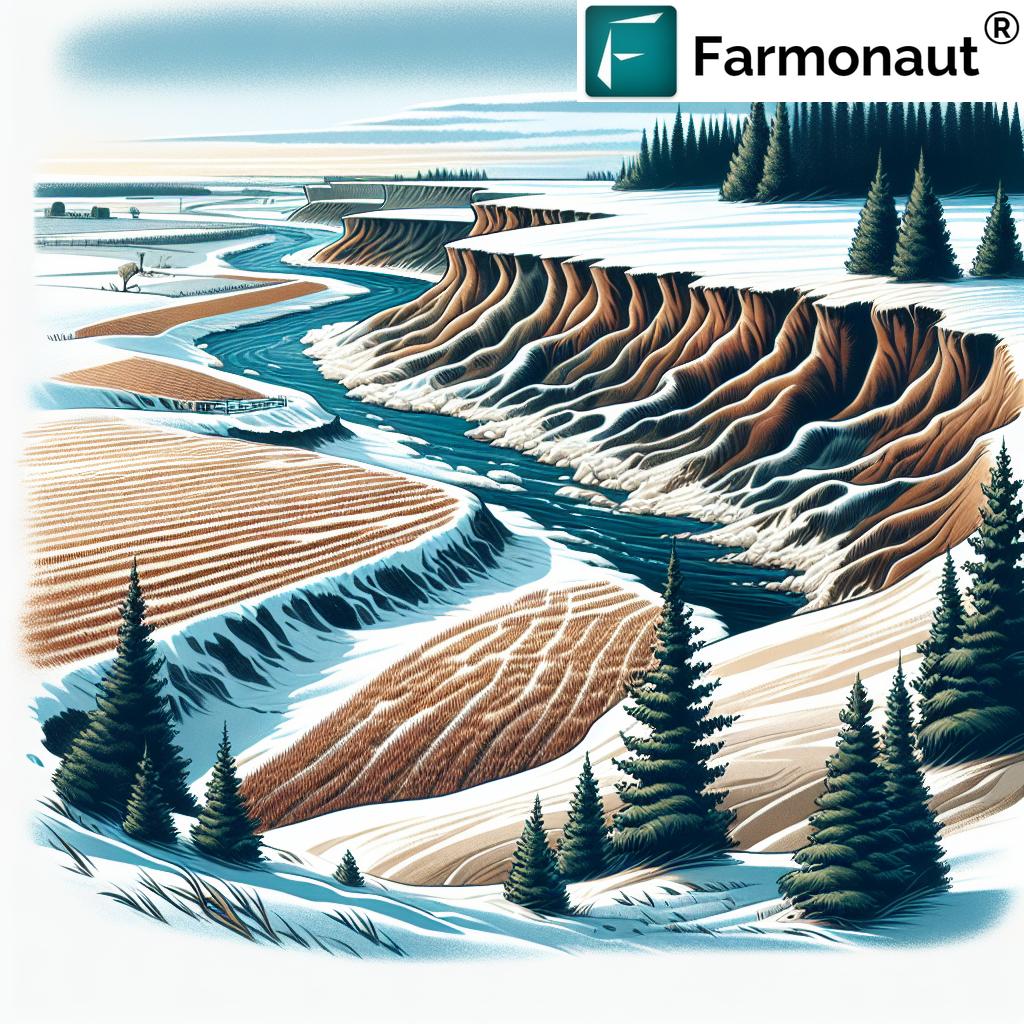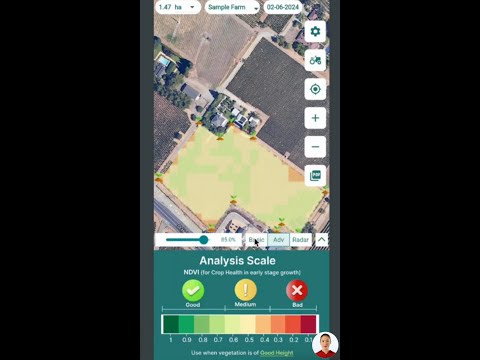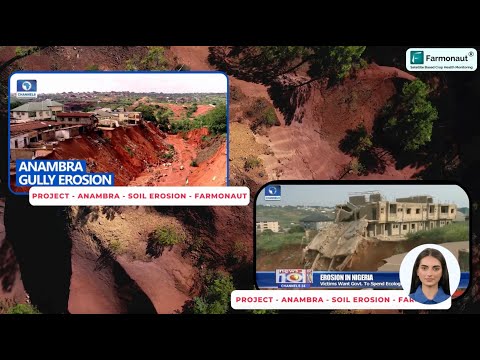Winter Soil Erosion in North Dakota: Sustainable Practices for Topsoil Conservation and Water Quality
“Each inch of eroded topsoil costs North Dakota farmers approximately $700 per acre in lost fertility.”
As we delve into the pressing issue of winter soil erosion in North Dakota’s Red River Valley, it’s crucial to understand the far-reaching implications of this environmental challenge. The lack of snow cover combined with high winds has led to a devastating loss of topsoil, threatening both agricultural productivity and water quality in the region. In this comprehensive exploration, we’ll examine the causes and consequences of winter soil erosion, highlight sustainable practices for topsoil conservation, and discuss the economic and environmental impacts of this ongoing problem.
The Stark Reality of Winter Soil Erosion in North Dakota
The Red River Valley, known for its fertile farmland, is facing a critical challenge this winter. The absence of snow cover has left the soil exposed to the harsh North Dakota winds, resulting in extensive erosion. Josh Anderson, watershed coordinator for the Walsh County Three Rivers Conservation District in Park River, North Dakota, paints a vivid picture of the situation:
“We’re certainly seeing a lot of dirt in the ditches and a lot around farmsteads — just a lot that’s been blowing because we have such a lack of snow cover this winter,” Anderson explains. “North Dakota is one of the windiest places in the country, so we’re still seeing lots of winter soil erosion.”

The evidence of this erosion is hard to miss. Ditches filled with black topsoil or “snirt” (a combination of snow and dirt) are visible throughout the landscape, serving as a stark reminder of the ongoing loss of valuable topsoil.
The Alarming Rate of Topsoil Loss
To fully grasp the severity of the situation, we need to look at the historical data. Two soil depth studies conducted by North Dakota State University (NDSU) – one in 1960 and another in the early 2010s – revealed a shocking statistic: Walsh County lost 50% of “certain topsoil types” in that 50-year period. Even more concerning is that this data is already 15 years old, and the problem continues to worsen.
The economic impact of this topsoil loss is staggering. According to an article published in the July 21, 2021, edition of Crop and Pest Report by NDSU soil scientist Dave Franzen, every inch of topsoil lost costs producers nearly $700 an acre in lost soil fertility. This hidden cost accumulates over time, forcing farmers to increase fertilizer rates to maintain productivity.
The Link Between Soil Erosion and Water Quality
Winter soil erosion doesn’t just affect farmland; it has a significant impact on water quality in local watersheds. The eroded soil, often carrying synthetic fertilizers, makes its way into water bodies, leading to severe environmental consequences.
A prime example of this is the situation at Homme Dam in Walsh County. In September 2024, the dam recorded the highest levels of toxic blue-green algae in North Dakota. The North Dakota Department of Environmental Quality considers microcystin levels (a toxin produced by blue-green algae) higher than 8 micrograms per liter to be a risk. Alarmingly, the level at Homme Dam reached 29,300 micrograms per liter – nearly 3,700 times the reporting limit.
“Winter soil erosion in the Red River Valley threatens both farmland productivity and water quality in local watersheds.”
Sustainable Practices for Topsoil Conservation
In the face of these challenges, it’s crucial to implement sustainable practices for topsoil conservation. Here are some key strategies that farmers and land managers can adopt:
- Reduced Tillage: Minimizing soil disturbance is a fundamental principle of soil health. Practices such as no-till or strip-till can significantly reduce erosion by leaving more crop residue on the soil surface.
- Cover Crops: Planting cover crops after harvest or between cash crops helps maintain “living roots” in the soil, preventing erosion and improving soil structure.
- Windbreaks: Establishing rows of trees or shrubs can help reduce wind speed and protect soil from erosion.
- Crop Rotation: Diversifying crop types can improve soil structure and reduce the risk of erosion.
- Contour Farming: Planting across the slope rather than up and down helps slow water runoff and reduce soil loss.
The Role of Technology in Soil Conservation
Modern technology plays a crucial role in implementing and monitoring soil conservation practices. Farmonaut, a leading agricultural technology company, offers advanced satellite-based farm management solutions that can aid in soil conservation efforts.
Through its platform, Farmonaut provides real-time crop health monitoring, allowing farmers to track vegetation health, soil moisture levels, and other critical metrics. This data-driven approach enables farmers to make informed decisions about irrigation, fertilizer usage, and pest management, ultimately optimizing crop yields while reducing resource wastage.
Farmonaut’s AI-driven advisory system, Jeevn AI, delivers personalized farm advice, weather forecasts, and expert crop management strategies. By analyzing satellite data and other inputs, Jeevn AI generates customized recommendations that can help farmers implement and maintain effective soil conservation practices.
Economic Implications of Soil Loss
The economic impact of soil erosion extends far beyond the immediate loss of topsoil. Let’s break down the various ways in which soil erosion affects farm economics:
- Decreased Fertility: As mentioned earlier, each inch of eroded topsoil costs farmers nearly $700 per acre in lost fertility. This translates to increased fertilizer costs to maintain crop yields.
- Reduced Crop Yields: Eroded soils have lower water-holding capacity and fewer nutrients, leading to decreased crop productivity over time.
- Increased Operating Costs: Erosion can lead to the formation of gullies and rills, making farm operations more difficult and time-consuming.
- Loss of Land Value: Severely eroded land may become unsuitable for agriculture, significantly reducing its market value.
- Environmental Compliance Costs: As regulations tighten to protect water quality, farmers may face additional costs to implement mandatory conservation practices.
Grassroots Efforts to Promote Soil Health
Recognizing the urgency of the situation, local conservation districts are taking proactive steps to educate and engage farmers in soil health practices. The Walsh County Three Rivers Conservation District, for instance, is hosting a series of grassroots soil health talks throughout March. These events bring together soil health specialists, NDSU Extension experts, and Natural Resources Conservation Service staff to provide valuable information on available cost-share plans and to learn from local farmers about their soil health concerns, challenges, and goals.
These grassroots efforts are crucial in building a community-driven approach to soil conservation. By fostering dialogue and sharing knowledge, these initiatives can lead to widespread adoption of sustainable farming practices across the region.
The Role of Cover Crops in Winter Soil Conservation
Cover crops play a vital role in preventing winter soil erosion and improving overall soil health. These crops, planted after harvesting the main crop or between growing seasons, offer numerous benefits:
- Soil Protection: Cover crops shield the soil surface from wind and water erosion during the vulnerable winter months.
- Nutrient Retention: They capture and store nutrients that might otherwise leach out of the soil, reducing fertilizer needs for the next crop.
- Soil Structure Improvement: The roots of cover crops help improve soil structure, increasing water infiltration and reducing runoff.
- Organic Matter Addition: When terminated, cover crops add organic matter to the soil, enhancing its fertility and water-holding capacity.
- Weed Suppression: Some cover crops can help suppress winter weeds, reducing herbicide use.
Farmers in North Dakota are increasingly recognizing the value of cover crops in their winter soil conservation strategies. By selecting appropriate cover crop species and managing them effectively, farmers can significantly reduce erosion risks while improving their soil’s long-term health and productivity.
Water Quality and Soil Erosion: A Critical Connection
The link between soil erosion and water quality is a critical aspect of environmental health in North Dakota. As eroded soil makes its way into rivers, lakes, and streams, it carries with it a host of potential pollutants:
- Nutrients: Phosphorus and nitrogen from fertilizers can lead to algal blooms, as seen in the Homme Dam incident.
- Sediment: Excess sediment can cloud water, harming aquatic life and increasing water treatment costs.
- Pesticides: Agricultural chemicals attached to soil particles can contaminate water sources.
- Pathogens: Bacteria and other microorganisms can be transported with eroded soil, potentially affecting human and animal health.
Addressing soil erosion is thus not just an agricultural issue, but a crucial step in protecting the region’s water resources. Conservation practices that reduce erosion have a direct positive impact on water quality, benefiting both rural and urban communities.
Reducing Tillage Techniques for Erosion Control
Reducing tillage is one of the most effective strategies for controlling soil erosion, especially during the vulnerable winter months. Here are some key techniques:
- No-Till Farming: This practice involves planting crops without disturbing the soil through tillage. It leaves crop residue on the surface, protecting the soil from erosion.
- Strip-Till: Only the portion of soil that will contain the seed row is disturbed, leaving the rest of the field undisturbed.
- Ridge-Till: Crops are planted on ridges, with residue left on the surface between the ridges.
- Mulch-Till: This method involves leaving crop residue on the soil surface while using minimal tillage.
These reduced tillage practices not only prevent erosion but also improve soil structure, increase organic matter content, and enhance water infiltration. While the transition to these methods may require some investment in new equipment and practices, the long-term benefits to soil health and farm productivity are substantial.
Soil Fertility Management in the Face of Erosion
Managing soil fertility becomes increasingly crucial as erosion threatens to deplete nutrient-rich topsoil. Here are some strategies for maintaining and improving soil fertility:
- Regular Soil Testing: Conduct frequent soil tests to monitor nutrient levels and adjust fertilization accordingly.
- Precision Agriculture: Use GPS and satellite technology to apply fertilizers precisely where needed, reducing waste and potential runoff.
- Organic Matter Addition: Incorporate compost, manure, or crop residues to improve soil structure and nutrient content.
- Crop Rotation: Rotate crops to balance nutrient uptake and reduce pest and disease pressures.
- pH Management: Maintain optimal soil pH to ensure nutrients are available to plants.
By implementing these practices, farmers can mitigate the impacts of erosion on soil fertility and maintain productive farmland for years to come.
Wind Erosion Control Strategies
Given North Dakota’s windy climate, specific strategies for controlling wind erosion are essential:
- Windbreaks: Plant trees or shrubs in rows perpendicular to prevailing winds to reduce wind speed at ground level.
- Strip Cropping: Alternate strips of erosion-resistant crops with more vulnerable crops.
- Maintain Crop Residue: Leave crop stubble and residue on the field to protect the soil surface.
- Emergency Tillage: In extreme cases, create rough soil clods to resist wind erosion.
- Cover Crops: Plant winter-hardy cover crops to protect soil during vulnerable periods.
These strategies, when implemented effectively, can significantly reduce the risk of wind erosion, especially during the harsh winter months when the soil is most exposed.
Conservation District Programs: A Vital Resource
Conservation districts play a crucial role in promoting and supporting soil conservation efforts. These local organizations offer a variety of programs and resources to help farmers implement sustainable practices:
- Cost-Share Programs: Financial assistance for implementing conservation practices.
- Technical Assistance: Expert advice on selecting and implementing the most appropriate conservation measures.
- Equipment Rental: Access to specialized conservation equipment that might be too expensive for individual farmers to purchase.
- Educational Workshops: Regular training sessions on the latest conservation techniques and technologies.
- Demonstration Projects: Showcasing successful conservation practices in action to encourage wider adoption.
Farmers are encouraged to reach out to their local conservation district to learn about available programs and how they can benefit from these resources.
The Future of Sustainable Farming in North Dakota
As we look to the future, it’s clear that addressing winter soil erosion and promoting sustainable farming practices are crucial for the long-term viability of agriculture in North Dakota. By combining traditional wisdom with modern technology and scientific understanding, we can create a more resilient and sustainable agricultural system.
Farmonaut’s innovative satellite-based solutions are at the forefront of this agricultural revolution. By providing farmers with real-time data and AI-driven insights, Farmonaut empowers them to make informed decisions about soil management, crop health, and resource allocation.
As we continue to face the challenges of climate change and increasing demand for food production, the adoption of sustainable practices and innovative technologies will be key to preserving our valuable topsoil, protecting water quality, and ensuring the long-term prosperity of North Dakota’s agricultural communities.
Comparison Table: Winter Soil Erosion Impact and Conservation Practices in North Dakota
| Factor | Without Conservation Practices | With Conservation Practices |
|---|---|---|
| Estimated topsoil loss (inches/year) | 0.5 – 1.0 | 0.1 – 0.3 |
| Economic impact ($/acre) | $350 – $700 | $70 – $210 |
| Water quality impact (algae bloom risk) | High | Low to Moderate |
| Soil fertility (nutrient retention %) | 40 – 60% | 70 – 90% |
| Wind erosion resistance (scale 1-10) | 3 – 5 | 7 – 9 |
| Soil moisture retention (%) | 50 – 70% | 75 – 90% |
Conclusion
Winter soil erosion in North Dakota’s Red River Valley is a complex challenge that requires a multifaceted approach. By implementing sustainable practices, leveraging technology, and working together as a community, we can protect our valuable topsoil, improve water quality, and ensure the long-term viability of agriculture in the region.
As we move forward, it’s crucial that farmers, conservationists, researchers, and policymakers continue to collaborate and innovate. By embracing sustainable farming practices and cutting-edge technologies like those offered by Farmonaut, we can create a more resilient and productive agricultural system that will sustain us for generations to come.
FAQ Section
- Q: What are the main causes of winter soil erosion in North Dakota?
A: The primary causes are lack of snow cover, high winds, and exposed soil due to conventional tillage practices. - Q: How does soil erosion affect water quality?
A: Eroded soil carries nutrients, sediments, and potentially harmful substances into water bodies, leading to issues like algal blooms and decreased water clarity. - Q: What are some effective conservation practices for preventing winter soil erosion?
A: Key practices include reduced tillage, cover cropping, windbreaks, and maintaining crop residue on the soil surface. - Q: How can technology help in soil conservation efforts?
A: Technologies like satellite imaging and AI-driven advisory systems, such as those offered by Farmonaut, can help farmers monitor soil health and make informed decisions about conservation practices. - Q: What resources are available for farmers looking to implement soil conservation practices?
A: Local conservation districts offer various programs, including cost-share opportunities, technical assistance, and educational workshops to support farmers in adopting conservation practices.
Earn With Farmonaut: Affiliate Program
Earn 20% recurring commission with Farmonaut’s affiliate program by sharing your promo code and helping farmers save 10%. Onboard 10 Elite farmers monthly to earn a minimum of $148,000 annually—start now and grow your income!
By implementing these sustainable practices and leveraging innovative technologies, we can work together to combat winter soil erosion, preserve our valuable topsoil, and ensure a sustainable future for agriculture in North Dakota and beyond.







